Festival Management and International Collaboration
Muto: Who are the audience in your projects?
Olé: It depends. In the case of the dance festival in Thakhek, it is mostly students. After six months of training, we hold an inter-school competition for them. The Urban Youth Dance Project (UYD), which was set up to raise funding to improve conditions of the village schools, invites the general public in the village to performances by young dancers and students. The Fang Mae Khong International Dance Festival is a contemporary dance festival where professional and aspiring dancers from Europe and Southeast Asia meet. Here, we present works that fuse street dance, contemporary dance, and Cambodian and Thai traditional dance. This applies not only to dance but also to music, graffiti art, video, and so on. We create a mixture of all kinds of genres. Sometimes, there are audiences who come from abroad too, so the atmosphere is quite international.
Muto: It seems your approach to dance is very diverse.
Olé: We also have very good staff in Laos who help us greatly.
Nout: We have a staff of six, but young volunteers join us too. Every year, they learn how to manage and run projects with us.
Muto: Olé, do you consider yourself the leader of the entire team?
Olé: I'm not sure, because we all work together. But, nevertheless, the Fang Mae Khong International Dance Festival was possible because I had connections to Southeast Asian artists. I had done residencies in Laos, Myanmar, Thailand, Cambodia, and Singapore since 2006, and the networks I had built from these residencies is the basis of the festival. Since I was able to acquaint myself with artists from each of these countries, I asked them to take part in the international dance festival that was to be the first in Laos. I also spoke with French choreographers that I know, applied for governmental grants in Laos, France, and the United States, and looked for private sponsors too.

Muto: Are there many private sponsors?
Olé: Yes, but they're mostly foreign companies, such as hotels, restaurants, and trading companies from France, other European countries, and the United States.; they understand the importance of culture. Anyone who has lived in France will immediately understand "dance festivals" so they'll be very supportive of the idea of having something like that in Laos too.
Muto: All the fundraising, choreography and production, managing projects, and also your philanthropic work must keep you very busy. How long do you stay in Laos for your projects?
Olé: Three times a year and about 40 percent of the year. I spend the rest of the year either in France or another country. I have a project in Singapore too, so I sometimes stay there for about a month.
Muto: I think it is unique that you organize collaborative projects in Asia, because I would assume collaborations between the West and Asia are more prevalent, since you're more likely to raise funds from Western organizations.
Olé: You're right; it is easier to get funding in Europe. But there are many international organizations and European foundations in Southeast Asia, too. The Institut Français supports us in many of the countries. So there are foreign organizations that can help us in Asia. But, at the same time, I place importance on the development of this space called "Southeast Asia" that consists of Laos and its neighboring countries. It is easy to travel to Laos from, say, Thailand or Cambodia, and since Laos shares borders with three other countries, it is very accessible. I have many friends in France so I also take Laotian artists to France every year; I organize a one-month tour where they work with French artists, and also introduce Laotian culture through dance, music, and food to the French counterpart.
Nout: For that, we have classes on Laotian cuisine and traditional dance too.
A Methodology for Heterogeneity
Muto: I'd like to talk about your pieces now. Was Kham…, from 2007, your first solo piece?
Olé: Yes, it was. It was a commission by Le Tarmac, a theater in Paris. I told the artistic director that I am going to go to Laos and Thailand to study traditional dance, and he gave me the opportunity to make a work out of it. Initially, my intention was to go there for my personal study and to develop my creativity, but I was encouraged to present a solo piece after the visit.
Muto: And you incorporated not only street dance and contemporary dance but also many other different styles.
Olé: Yes. Institut Français invited me to perform it at each of their branches. My approach to the traditional is through contemporary or current forms, and I consider street dance one of "the traditional" too. Institut Français wants to encourage young break dancers to work toward a kind of creative meaningfulness, going beyond simply practicing to improve their skills. Indeed, most dancers think street dance is "cool;" it is like sports or shows to them. They continuously aspire to be "number one." (laughs)

Muto: (Watching the video recording of the piece) Is this your latest piece, Fang Lao?
Olé: Yes, it is. The members of the Fanglao Dance Company and French dancers performed it. It involves street dance, Laotian traditional dance, contemporary dance, and a musician who uses five instruments. I wanted to have electronic sounds incorporated into the piece, so we also had a French music composer work with us.
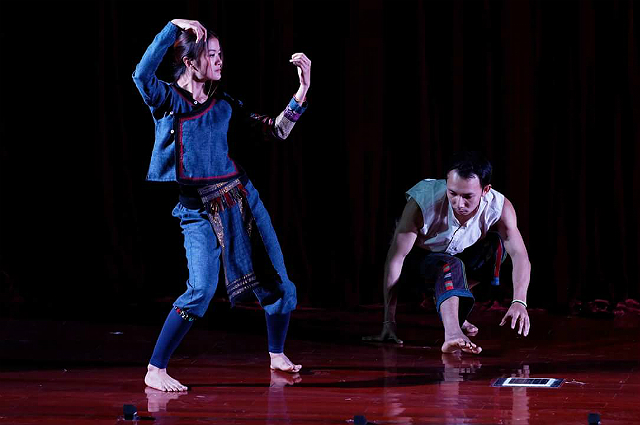
Muto: I see that people with so many different genres and styles had come together but are there many dancers and musicians who organize this kind of collaboration just as you do?
Olé: There are, both in France and Southeast Asia. I have also worked with Thai and Singaporean dancers.
Muto: Did those dancers study in your workshops and schools?
Olé: They come to our workshop first, and then polish their techniques on their own. Now Fanglao Dance Company has a studio, so they practice there.
Nout: It was finally built in July 2015. There weren't any schools or facilities where you could study dance, but now we can practice there.
Muto: What are the concepts behind your merging different genres?
Olé: While I am the choreographer, I usually work together with the performers: through improvisations, we expand our ideas, find concepts or notions that need to be explored, and develop on them. When we were working on Fang Lao, there was a dancer who had studied Muay Lao (Laotian martial art). Shall we take a look at it?. The movements are quite similar to animals.
Nout: As you can see, Muay Lao involves a lot of steps.
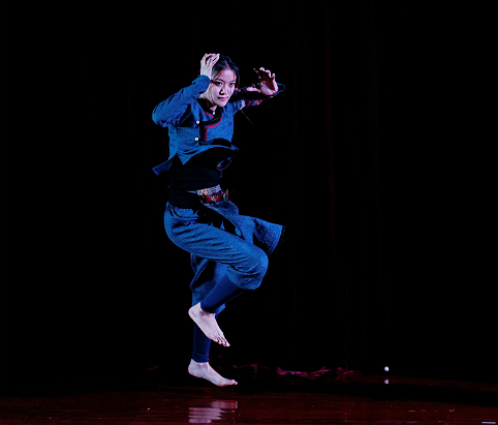

Muto: I see. There is also a clear fusion between street and traditional dance. In traditional dance, I think you stay upright and movement is articulated mostly through your arms and hands. But for street dance, you use your entire body. So what were your methods of combining them?
Olé: Whether it is street dance, traditional dance, contemporary dance, or ballet, I think it's all about the technique. When you articulate a flower using your hands, while it is a simple movement it still requires technique. So rather than trying to attach meaning to individual movements, I try to find commonalities in the use of the movements and the energy. Laotian dance usually consists of very slow movement, for example.
Nout: And softness, too. Smiling softly, for instance, is essential in Laotian traditional dance.
Olé: But, at the same time, you find similarities between street dance and traditional dance too. One example is the dynamic use of energy in, say, the character of the monkey warrior in Khon, as it closely resembles the movements in break dance. Butoh and break dance, too, look similar when the movements are slow. Just as hip-hop culture developed from a form of street gang culture into a form of art, the element of "evil" is an important aspect in butoh, too. Contemporary dance also explored movements and articulation that were unacceptable in the world of ballet, so they are somewhat similar. As such, you can find similar movements and elements between different styles.
Muto: That is true. There are similarities where emerging genres "deviate" from the conventional.
Olé: Capoeira in a way, too, is a deviation because their "dance" was in fact a form of martial arts where they practiced their fighting moves while pretending to dance.

Muto: You've incorporated video images into this piece (pointing at computer screen).
Olé: It's titled Akalika 1 We collaborated with a painter where we projected his paintings onto the stage. We've never shown this one in Laos. The piece is quite dark in tone; the painter paints his body in black and makes himself look as if he doesn't have a head. By incorporating his paintings, I tried to deal with the "evils" that inherently exist within ourselves. This being said, however, the message of the performance itself is quite a positive one because it demonstrates the energy of dance.
This is the latest piece, Fang Lao. It's a joyous piece that involves a lot of elements from break dance and Laotian traditional dance. The costumes are beautiful too, aren't they?
Muto: Yes, they are. So, here, you're overlapping moves from break dance with the rhythms of Laotian traditional dance?
Olé: Yes. There is also a scene where we combined khene (a Laotian traditional mouth organ) with a chapy (a Laotian electric guitar) as the "music" for the break dance.
Muto: The dancers are moving very softly. I have never seen anything like this.
Nout: They're breakdancing with the movements of traditional dance.
Olé: The musicians also focused on the rhythms in particular. It was apparently a new experience for them too.
Muto: In Laos, what kind of economic environment has dance been in?
Olé: There are only three professional dancers in Laos. The idea that you can actually make a living as a dancer is still something very new there. So, by demonstrating that it is possible to earn a living in this field, I am hoping the field will continue to develop. For example, being a professional dancer and choreographer myself, in France, I can make a living by working steadfastly. However, in Laos, you can only make a living as a dancer or choreographer for traditional dance or music as a member of the official art troupe. As a street dancer or contemporary dancer, you have no choice but to stay freelance. That is why we have been working hard to ask for support from various organizations, and why we participated in TPAM 2016. Several organizations have visited Laos and have started to support us for exchange projects. Laos is just beginning to open itself up to the outside: the country is now at a stage where its aspiring dancers and choreographers want to welcome artists from overseas, to work with them, share experiences, and to develop their skills with the aid of these stimuli.
Muto: The Japan Foundation established its Vientiane office last year. In addition to Institut Français, is there also the Goethe Institut in Laos?
Olé: Not yet, but their staff members come from Bangkok. It seems their Bangkok office covers Vientiane too.
Muto: So, would you say French influence is stronger there?
Olé: Yes. To be honest, that is an advantage for me. It is easier for me to apply for Institut Français' grants. They kindly help me almost every year. But, as I said earlier, I really would like local government and municipalities support us too. It is hard to receive funding from the central government despite them being supportive of our events. We still have to ask private corporations and organizations for their help. It is very different from the conditions in France. My company has been fortunate enough to have support from the government, so our creative environment is relatively good. At the same time, we also cooperate with the theaters too, so it makes life a little easier. In Laos, on the other hand, you definitely need personal connections.
Muto: Is there a national dance company?
Nout: There are companies for traditional dance.
Olé: Yes, there are many national dance companies. But, as Nout said, so far, the government engages only in traditional dance. Practices of individuals are not yet supported.
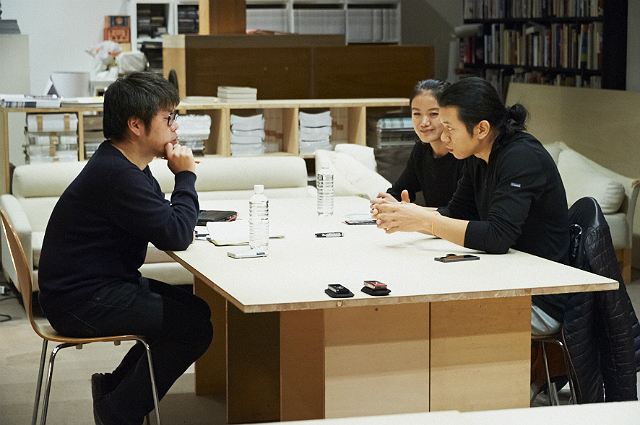
Photo: Jouji Suzuki
Future Visions
Muto: If you were to name one, who is the choreographer that has influenced you the most?
Olé: I do not have one specific choreographer. I think the ordinary people in our everyday lives are the ones who inspire me.
Muto: Are you interested in other choreographers who bridge traditional culture and contemporary culture, such as Akram Khan or Pichet Klunchun?
Olé: Not really, to be honest. But I have known Pichet since 2007, and, for a project in 2017, we are planning to create a duo piece which is scheduled to tour in France and Asia. Well, yes, Pichet's works consist of the traditional and the contemporary, so it is interesting. His works are very strong in that regard.
Muto: What about you, Nout? Who is the choreographer that has influenced you the most?
Nout: I haven't seen many pieces, I'm afraid, so Olé is my idol. He has taught me so many things. Every piece is different, and he works very hard on every one of them. We wouldn't have been able to make Fang Lao without him. Other people that I know of are Pichet and Arco Renz. *5
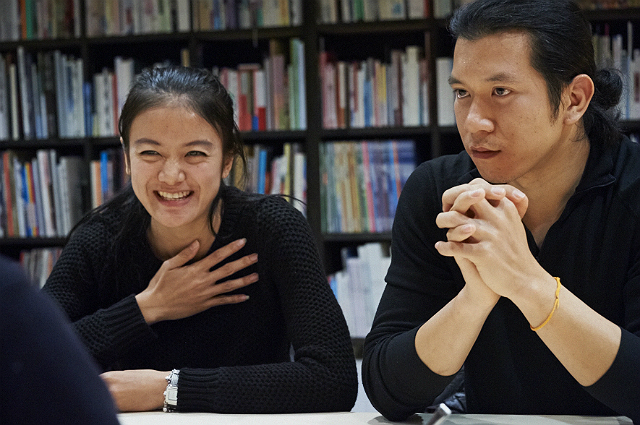
Olé: I have been trying to contribute to Laotian and the artists both at home and abroad when I work with artists and organizations. I often ponder whether I would be here, now, doing what I do if I had lived in Laos throughout my life. I am what I am now because I grew up in France, in a society that places importance on culture, and was able to immerse myself into my training. I was given that opportunity in France. I imagine my life would have been very different if I had stayed in Laos.
Muto: Could you both share your future visions with us?
Nout: I want to be recognized as a choreographer, and also want people across the world to see my pieces created in Laos. I want to demonstrate to dancers in Laos how to pursue dance, not as a hobby, but as a profession. As Olé mentioned earlier, it is very possible to earn a living as a professional dancer, so I would like to continue on that path.
Olé: There are many things that still need to be done in my current projects, so I just have to carry on with them bit by bit. But I do want to continue to create new pieces and dance since I am not a festival manager or organizer but a dancer and choreographer at heart.
At the same time, however, there are Laotian dancers who really devote themselves to the events I organize. They save their money, do teaching jobs, and find sponsors so that they can afford the studio rental fee. They go through so much just to continue to dance. I think it is safe to say that I do what I do precisely because of them. They undoubtedly help me a lot, too. I do advise them to acquire the techniques to teach others, too, though. If you have the skills to teach, you can assess others, collaborate with others, and possibly be invited to festivals and see other types of pieces, and ultimately deepen and broaden your own creative process. If you do not expose yourself to many performances, you could end up not being aware of the conditions outside your own country.
Muto: I very look forward to your future activities. Thank you very much.
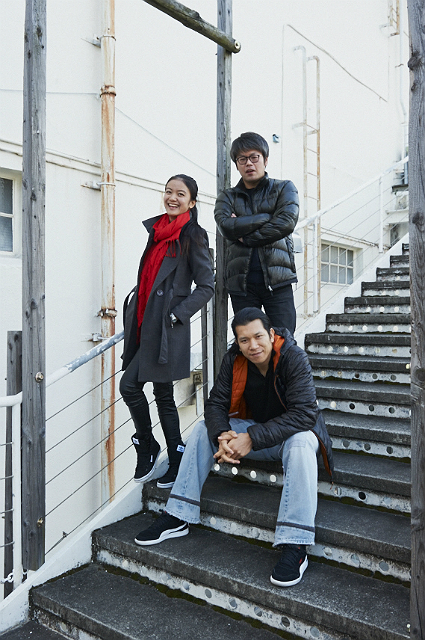
[February 8, 2016, at BankART Studio NYK]
*5 A Belgian choreographer and dancer. In the field of contemporary dance, he has been creating works together with local dancers especially in Asian cities.
Interview and text : Daisuke Muto
Dance critic and Associate Professor at the Faculty of Literature, Gunma Prefectural Women's University. Studies the global history of dance with a focus on Asia in the 20th century and develops an alternative choreographic theory based on the study. Contributed essays in Choreography and Corporeality: Relay in Motion (Palgrave Macmillan, 2016) and History of Ballet and Dance (Heibonsha, 2012). Articles written include "Kazuo Ohno's 1980" (Bulletin of Gunma Prefectural Women's University, No. 33, 2012) among others. Choreographed Surely It Comes About (2013).






